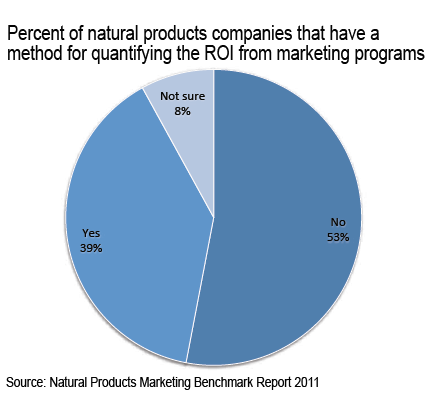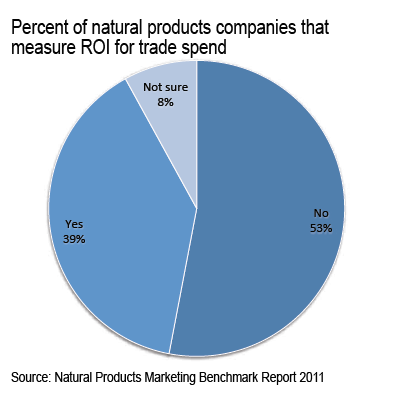|
If there is one finding in from the Natural Products Marketing Benchmark Report 2011 that’s shocking, it has to be that only 39% of respondents had a method for quantifying their marketing’s ROI. In an age where you have the tools to measure just about anything, why is it that natural products companies don’t keep tabs on what their marketing really does for them? They have the motivation to do so. According to the Report:
ROI Obstacles In fairness to marketers selling natural products, they face some obstacles that hamper their ability to measure their ROI. Sell-through figures: Not all stores provide sell-through figures. If you have a marketing campaign that integrates local advertising, live demos, new POP and limited-time discounts, it’s difficult tracking the ROI when the store doesn’t give you the information on how the products sold through during the period of the campaign. The only thing you have to work with is the quantity of products you sold to the store before and after the campaign. You also need the year over year comparisons. So it’s hard, but not impossible. ‘Cost-of-doing-business’ trade marketing: In the Benchmark Report, the percent of those that measure the ROI of their trade spend is paltry. The only reason that I can see for this is that marketers must be resigned to the unfortunate fact that their trade spend is the price of doing business in the industry. Much of their trade dollars go to non-working marketing and sales spends like unauthorized deductions and distributor and retailer fees, as well as to those programs that they feel they have support to remain on the shelves such as distributor and retailer advertising. Maybe their logic is since this is the cost of doing business, why put an ROI on it?
Mmmm. Even a small amount of ROI measurement is better than no measurement at all. Start Small Setting up the analytics and tracking ROI is not easy. It requires commitment and skill. At times it can seem overwhelming which is probably why larger companies are more likely to track marketing ROI than smaller ones (Data from Natural Products Marketing Benchmark Report 2011). The thing to remember about ROI is that it’s a measurement, and all measurements are relative. For ROI you want to set up some kind of benchmark from which you can start measuring the effectiveness of your marketing. The extremely broad measurement (year over year marketing spend vs. year over year sales) won’t really help you because it can’t point to which tactic worked best. I’m not going to discuss marketing ROI from web sales, since that is a different animal from trying to measure ROI from store sales. Suffice to say that with all of the analytical and tracking tools at your disposal for web sales, can you really think of a good reason NOT to measure your marketing ROI? But back to store sales. For those who don’t do ROI for their marketing, start small and conduct tests. Pick two to four similar shopping environments (same size towns, same store makeup, same sales etc.) and split them up. Half get one marketing campaign and the other half get another. The ideal would be to have the store agree to give you sell-through figures. But if you can’t get that, try to get the stores to order at the same time before the test. That way you can see which stores will place a new order the soonest during or after the test. Keep tabs on the marketing expenses (you need that in order to calculate your ROI later). After the test compare the sales. Keep in mind, ROI is not the same as results. One type of campaign might get you better results but it might cost more than the other. The ROI is calculated by the formula - (Profit minus Investment) divided by Investment. What you might discover from this is that your live demo program which gave you great results may actual be less profitable than the radio campaign in the other market (or visa versa). That’s the value of ROI. Remember, if your main marketing challenges are not enough budget or convincing your boss, ROI is an excellent way to make your case. Without it, it's just you pushing the same boulder.
0 Comments
Your comment will be posted after it is approved.
Leave a Reply. |
AuthorArchives
June 2011
Categories
All
|
|
Pioneer Communications Group is a marketing firm that specializes in helping small businesses that want to engage with their customers and prospects effectively, and profitably. We are expert in marketing strategy, communications, market research, marketing automation, and content creation. © 2016-Pioneer Communications Group
|



 RSS Feed
RSS Feed